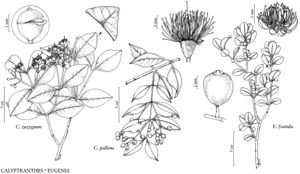Calyptranthes pallens
Abh. Köngl. Ges. Wiss. Göttingen 7: 215. 1857.
Shrubs or trees 5–10 m, with dense foliage and rounded crown, indumentum usually abundant on young stems and inflorescences, hairs light brown to yellowish white, dibrachiate. Young stems narrowly 2-winged; bark pale gray or nearly white, smooth or, ultimately, scaly. Leaves: petiole 4–8 mm, channeled, puberulous; blade elliptic to ovate, 3–6(–10) × 2–4(–6) cm, midvein sulcate adaxially, lateral veins 10–15 pairs, indistinct on both surfaces, marginal vein 1, 1–2 mm from margin, similar in prominence to lateral veins, slightly arched between lateral veins, base obtuse to cuneate, apex acute to acuminate, slightly recurved, surfaces usually appressed-pubescent abaxially, sometimes glabrescent, lustrous adaxially and appressed-puberulous or glabrous, glands slightly impressed adaxially when dried. Peduncles slender, 2–4 cm. Inflorescences (20–)30–50+-flowered, 7–15 cm, tomentulose; bracts deciduous, ovate, acuminate; bracteoles early deciduous, minute. Pedicels 1–2 mm. Flowers fragrant; bud narrowly obovoid, 2–3 mm, appressed-pubescent; hypanthium narrowly crateriform, cylindrical in fruit, 2 mm wide; calyptra 2 mm wide, obtuse to rounded; stamens 5 mm; style 4 mm. Berries lustrous dark purplish black, spheroid, 5–8 mm diam., crowned by cylindrical hypanthium when mature, glabrous or sparsely pubescent. Seed 4 mm diam.
Phenology: Flowering late spring–mid summer.
Habitat: Subtropical hardwood hammocks.
Elevation: 0–10 m.
Distribution
Subtropical hardwood hammocks, Fla., West Indies, Central America.
Discussion
Calyptranthes pallens is known in the flora area from the southern peninsula coast, the Everglades, and the Florida Keys, in Collier, Miami-Dade, and Monroe counties.
Calyptranthes pallens is easily distinguished from C. zuzygium by the abundant, tightly appressed (versus glabrous) indumentum, the narrowly winged (versus unwinged) stems, the sulcate (versus convex) midvein on the upper leaf surface, and the obtuse to rounded (versus apiculate) calyptra. As circumscribed here to include a variety of forms from throughout its range, C. pallens is variable in leaf size and presence/absence of indumentum and stem wings. However, collections from Florida are uniform in these features with leaves on the smaller end of the size range given, the presence of pale brown or yellowish white indumentum on the young vegetative parts and inflorescence, and the presence of stem wings. Calyptranthes pallens is listed as threatened in Florida.
The fruits are edible and have an agreeable, spicy taste; ripening occurs unevenly over a period of weeks, giving the infructescence a distinctive appearance with green, red, orange, and purplish black fruit present at the same time. The brown heartwood is close-grained, heavy, and hard (J. K. Small 1933).
Selected References
None.
